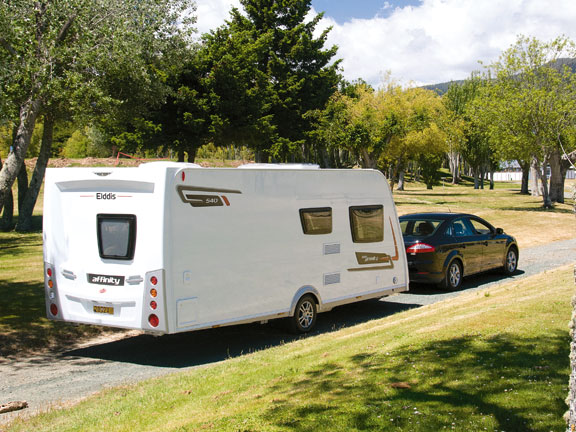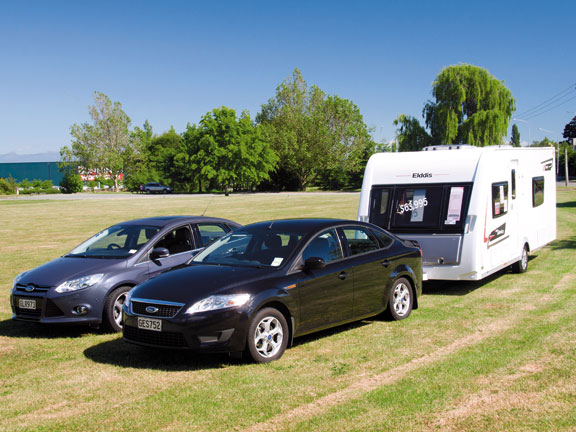There's a new breed of caravan owners enjoying the pleasure of roaming around New Zealand in their own mobile home. They do not own a 4WD or large ute, which are the traditional tow vehicles for Kiwi and Aussie caravans. Instead, they use their fuel-frugal, medium-sized family saloon to tow a lightweight caravan. Made in Europe, the UK and Australia, these caravans are designed and built to meet the needs of people who own just one car.
In a positive step from a purchaser's perspective, the manufacturers of at least four brands of imported lightweight caravans – Bailey, Burstner, Elddis from the EU, and Jurgens from Australia – have appointed New Zealand agents offering a comprehensive range of models with full after-sales service, parts supply and a factory warranty on the products they sell.
I asked Barry Avery of RV Leisure Centre in Nelson why he had taken up the Elddis agency when he was already selling locally-built Southern Star and CI Munro caravans. His reply was an interesting observation of what was occurring in the market place.
“We saw the Elddis range complimenting the two existing brands. The brands appeal to traditional Kiwi caravanners, who enjoy the benefits of well-made New Zealand products built to last 50 years, and are happy to buy a large 4WD or ute to tow them,” he says.
“Elddis buyers, on the other hand, are mostly newcomers to caravanning who don't want to buy a special towing vehicle. They want a well-appointed caravan they can tow with their family car.
“The Elddis range fits that niche and introduces new buyers to the world of caravanning. It expands the market of caravan owners. “Once they get hooked on caravanning, they could easily transfer their allegiance to a New Zealand-made product.”
Such caravans are lighter than New Zealand buyers are accustomed to. Three single-axle caravans of around six metres in body length were recently reviewed in MCD. All had GVM's of between 1300kg and 1760 kg:
- Burstner Premio 495TK, GVM 1300kg (MCD#96 Sept 2012);
- Elddis Affinity 540, GVM 1450kg (MCD#101Feb 2013);
- Jurgens J2205, GVM of 1760kg (reviewed MCD#97 Oct 2012);
EU caravan manufacturers, and Jurgens in Australia, embrace new technology to help reduce the overall weight of their products such as lighter-engineered chassis and axles, foam sandwich construction walls, roof, and floors, and lightweight ply for their cabinetry. In a first for the industry, one UK-manufactured range of caravans for 2012 includes models that are glued together using the same product used in Formula One racing cars, super yachts, and most recently, to glue wings on aircrafts. The bucket of nuts, bolts, and screws they cast aside using this adhesive process translates into fuel savings for the life of the caravan.
They work closely with component manufacturers like chassis makers Alko and BWP. Their new stability hitches and electronic control systems have been developed to make towing safer. Anti-sway hitches have pads that squeeze the tow ball when the hitch lever is lowered into the connect position. It helps diminish caravan sway when the vehicle is in motion. The electronic stability control system (similar to those being offered on motorcars) senses when the caravan sway movement exceeds safe parameters – for example, when swerving to avoid a hazard. Braking is automatically applied to the appropriate caravan wheel to keep the caravan tracking safely throughout the manoeuvre. New-technology items like these are offered as standard on many EU caravans and the Jurgens range from Australia.
These caravans are so different from what traditional Kiwi caravan users and manufacturers are used to, there is, understandably, some scepticism about the durability and longevity of lightweight caravans. Is their scepticism justified?
Based on the experiences of servicemen who have repaired faults on EU imports over the past five years, they have a point. But if you asked yourself, 'do those imports represent an accurate sample of current EU building standards?' to be fair, you'd likely say, 'probably not'.
In New Zealand we have had more than our share of flood-damaged and restored write-offs amongst imported second-hand caravans, so faulty products like this are not a reasonable basis for fair comparison.
It's sometimes said that only New Zealand made caravans can cope with New Zealand conditions. The reality is EU and New Zealand road and driving conditions are similar, with the majority of caravan journeying undertaken on well-sealed roads. Climate wise, the EU gets both hotter and colder temperatures than we do, with similar amounts of wind and rain. Their caravans are ventilated, insulated, and heated for temperate climates just like ours.
Compared with Australian ones, Kiwi and EU caravans have a quiet life. Australian caravans regularly travel 10,000km-plus on annual excursions to northern and western Australian states. The distances are relentless and they take their toll on vehicles and drivers, travelling 500km-plus a day at 90-100km/h for days at a time. Understandably, they need to build them tough!
So, what cars can we tow them with? If you are considering using your current car for towing a lightweight caravan, you need to know its towing capacity. You can find this in your owner's handbook. Otherwise, contact the sales or service agent for your car brand and ask them. You may need to provide your vehicle's VIN number before they can quote you the maximum capacity in kilograms that your vehicle can tow.
To give you an idea of what is possible, I checked out a few current 2012 models and this is what I found.
In all cases, these were the maximum tow weights for braked caravans:
- VW Passat: petrol, 1500kg; diesel, 1800kg;
- Peugeot 508 Active saloon: 1.6-litre petrol with 6-speed auto, 1775kg;
- Peugeot 508 Allure: 2.2-litre diesel HDi GT SW 6-speed auto, 1875kg (other Peugeot models had tow ratings between 1200 and 1600kg);
- Ford Mondeo Titanium: diesel/auto, 2000kg;
- Ford Mondeo: other models – between 1200 and 1600kg;
- Ford Focus Trend: hatch or S/W 2-litre diesel, 1500kg;
- Toyota Aurion: V6, 1600kg;
- Hyundai i45: 2.4-litre, 6-speed auto, petrol, 1700kg;
- Nissan Maxima: 3.5-litre V6, 1500kg;
- Subaru Legacy Warwick: S/wagon or saloon, petrol or diesel, 1500kg;
- Subaru Turbo: 1800kg;
- BMW 5 Series F10: up to 2200kg depending on engine variant;
- BMW 3 Series F30: up to 1800kg depending on engine variant;
The above list of cars does not contain all the current models capable of towing lightweight caravans. Curiously, some older models have higher tow ratings than current models, so it is always worth looking into. It doesn't pay to be cavalier about observing these maximum weight limits. The traffic authorities are beefing up their policing of vehicles towing caravans and boats, and insurance companies check that maximum weights have not been exceeded in all claims resulting from accidents. That aside, you are nuts if you overload your vehicle and potentially endanger lives in the process.
Caravanning can be a lifelong experience; wonderful for families, couples, and singles. So if you have suppressed the urge to take it up, suppress no longer. The very competitive caravan prices we are seeing today aren't going to last.
But be warned: you could get hooked for life and even find yourself checking the prices of 4WDs so you can move up to something bigger, bolder, and New Zealand-made.
Feel free to make a comment or ask us a question about this story on the MCD  page.
page.
For the latest reviews, subscribe to our Motorhomes, Caravans & Destinations magazine here.







